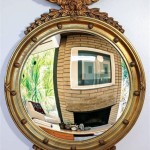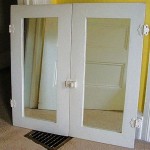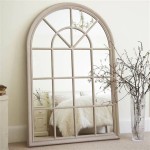What Height Should A Bathroom Mirror Be?
Determining the optimal height for a bathroom mirror is a multifaceted decision influenced by several factors. While a universal "right" answer doesn't exist, adherence to established guidelines and careful consideration of individual circumstances can ensure both functionality and aesthetic appeal. This article explores the key considerations that inform the ideal bathroom mirror height.
One of the primary goals of a bathroom mirror is to provide a clear and unobstructed reflection for all users. This necessitates positioning the mirror at a height that accommodates the height range of the individuals who will regularly use the bathroom. Furthermore, the mounting height should complement the existing bathroom fixtures, particularly the vanity and sink, contributing to a cohesive and balanced design.
Establishing a General Baseline
Industry standards and design principles offer a practical starting point for determining bathroom mirror height. A commonly recommended guideline suggests positioning the center of the mirror approximately 60 to 65 inches from the floor. This range generally corresponds to the average eye level of adults, allowing for comfortable viewing without excessive bending or straining. It's important to note that this is merely a starting point, and adjustments may be necessary based on specific user needs.
For instance, in a bathroom shared by adults and children, a lower mounting height may be considered to ensure accessibility for younger users. Conversely, in a bathroom predominantly used by taller individuals, a higher mounting height may be more appropriate. Ignoring these individual factors can lead to a mirror that is inconvenient or even unusable for certain members of the household.
The height of the vanity is another critical consideration. Ideally, the bottom edge of the mirror should be positioned a few inches above the backsplash of the vanity. This creates visual separation between the two elements while preventing water damage to the mirror's edge. A common practice is to aim for a gap of 4 to 8 inches between the vanity backsplash and the bottom of the mirror.
Accounting for Individual User Height
While the general baseline provides a useful starting point, truly optimizing bathroom mirror height requires careful consideration of the individuals who will be using the space. The height of the primary users should be measured to determine their average eye level. This can be done simply by having each user stand naturally and measuring the distance from the floor to their eyes. The midpoint of this measurement can then be used as the target center point for the mirror.
In households with significant height discrepancies, a compromise may be necessary. One approach is to prioritize the needs of the primary user while ensuring that the mirror is still reasonably accessible to others. Another option is to explore alternative mirror configurations, such as using multiple smaller mirrors or installing a tilting mirror that can be adjusted to different viewing angles. These solutions can provide greater flexibility and accommodate a wider range of user heights.
It is also important to consider any mobility limitations that may affect the user's ability to view the mirror. Individuals who use wheelchairs or have difficulty standing for extended periods may require a lower mounting height to ensure comfortable and convenient access. In these cases, careful planning and consultation with an occupational therapist or accessibility specialist may be beneficial.
When addressing height considerations, it is crucial to remember that the goal is to create a functional and comfortable space for all users. This may require making adjustments to the traditional guidelines to accommodate individual needs and preferences. Open communication with all members of the household is essential to ensure that the final decision reflects the needs of everyone who will be using the bathroom.
Considering Mirror Style and Size
The style and size of the mirror will also influence the optimal mounting height. Larger mirrors, for example, may require a slightly different approach than smaller mirrors. A tall, rectangular mirror may need to be positioned lower to ensure that the user's entire face is visible, while a small, round mirror may be mounted higher to create a more visually balanced composition.
The shape of the mirror can also affect the perceived dimensions of the bathroom. Vertical mirrors can create the illusion of height, while horizontal mirrors can make a small bathroom appear wider. These visual effects should be taken into account when determining the mirror's placement.
Framed mirrors present an additional consideration. The frame itself will add to the overall height and width of the mirror, and this should be factored into the measurements. It's important to ensure that the frame does not obstruct the user's view or interfere with the functionality of the mirror.
The style of the bathroom should also inform the choice of mirror and its placement. A modern bathroom may benefit from a minimalist, frameless mirror mounted at a slightly higher height, while a traditional bathroom may call for a more ornate, framed mirror positioned at a more conventional height. The goal is to create a cohesive and harmonious design that reflects the overall aesthetic of the space.
Furthermore, the presence of other bathroom fixtures, such as lighting and shelving, should be considered when determining mirror height. The mirror should be positioned in a way that maximizes natural light and minimizes glare. It should also be placed in a location that does not interfere with the use of other fixtures. Careful planning and attention to detail can ensure that the mirror is both functional and aesthetically pleasing.
Ultimately, determining the ideal bathroom mirror height is a process of balancing general guidelines with individual needs and design considerations. By considering these factors carefully, it is possible to create a bathroom that is both functional and visually appealing.
The mounting hardware for the mirror also plays a role. Ensure the hardware is appropriate for the weight and size of the mirror and the wall material it will be attached to. For heavy mirrors, professional installation is often recommended to ensure safety and prevent damage.
When marking the location for the mirror, use a level to ensure it hangs straight. A slightly crooked mirror can be visually jarring and detract from the overall aesthetic of the bathroom. Double-check all measurements before drilling any holes. It is advisable to have a helper hold the mirror in place to visualize the final placement before commencing with installation.

How High To Place Your Bathroom Fixtures Inspired Style

Bathroom Mirror Size Calculator

How To Hang A Wash Basin Mirror Step By Guide Accent

Bathroom Mirror Size Calculator

Guide To Hanging Bathroom Vanity Lighting And Mirrors Liven Design

The Right Height For Your Bathroom Sinks Mirrors And More

The Right Height For Your Bathroom Sinks Mirrors And More

Standard Height For Bathroom Mirror Dimensions Vanity Sizes Layout

How To Install Bathroom Sconces

Guide To Hanging Bathroom Vanity Lighting And Mirrors Liven Design








